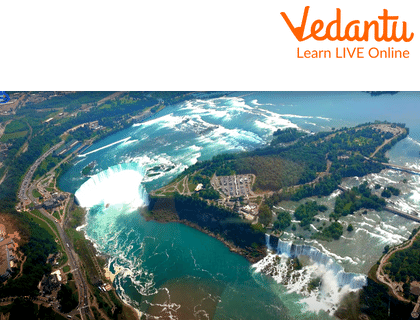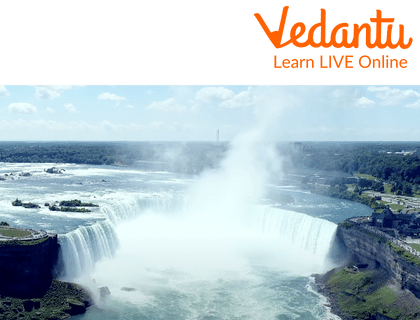




Niagara Falls: An Overview
Niagara Falls is located on the border between Ontario, Canada, and New York City, USA. This waterfall is a combination of three major and minor waterfalls. These waterfalls are American Falls, Horseshoe Falls, and Bridal Veil Falls. This waterfall is built on the Niagara river. The Horseshoe Waterfall of the United States is the most powerful waterfall here, in fact, this waterfall forms a shape like a horseshoe, hence it is called Horseshoe Waterfall. Niagara Falls is known for its hydroelectric power and is a valuable source of beauty. For other important information related to Niagara Falls, read this article completely, in which we are going to know the history of Niagara Falls and many other important things.
History of Niagara Falls
The history of Niagara Falls was told by different people in different ways.
According to Bruce Trigger, where Bruce Trigger explains the origins of Niagara, it is derived from the name given to an important branch of the local native Neutral Confederacy which was taken from Niagagarega, which was called by the French people during the 17th century.
According to George R. Stewart, it has been told about Niagara Falls that it comes from the name of the city of Iroquois.
The Frenchman Samuel de Champlain, during his Canadian trip, visited the place in early 1604 and some of his companions told him about this beautiful waterfall. It was later described by Samuel de Champlain in a magazine.
Niagara Falls Facts
The Geology and Facts of Niagara falls are listed below:
Niagara Falls is a source of water energy. They generate large amounts of electricity.
Electricity installations along the Niagara River provide more than a quarter of all energy used in New York and Ontario.
Niagara falls are made up of three other waterfalls, of which Bridal Veil Falls is the smallest waterfall and the largest waterfall is the Horseshoe Falls which is about 790 metres wide while another American Falls is 320 metres wide.
Niagara Falls State Park is the oldest state park in America, established in 1885 in the Niagara Reserve. Every year, more than 8 million visitors explore Niagara Falls State Park.
The largest vertical waterfall is over 50 metres.
Niagara Falls was formed by glacial activity about 10,000 years ago.
The energy of the Niagara River was used to generate hydroelectricity in the mid-18th century.
At the current rate of erosion, scientists believe that Niagara Falls will end in about 50,000 years.
Water flow is 567,000 litres per second.
Niagara Falls does not freeze in winter.

The Niagara Falls: Combination of Three Other Waterfalls.
How Tall are Niagara Falls?

Niagara Falls: One of the Tallest Waterfalls.
Niagara Falls is one of the largest waterfalls in the world and its height is 167 feet or 51 metres. It is a famous waterfall, known for its height.
Solved Questions
Where is Niagara Falls located?
Ans: Niagara Falls is a beautiful waterfall located on the international border between Ontario in Canada and New York City in the United States of America. The border between Canada and the United States is separated by Niagara Falls.
Which are the waterfalls combined with Niagara falls?
Ans: Niagara waterfall is a combination of three major and minor waterfalls. These waterfalls are:
American Falls
Horseshoe Falls and
Bridal Veil Falls
This waterfall is built on the Niagara river.
Learning by Doing
Write True or False.
Niagara Falls is located on the border of the United States and Canada.
Horseshoe Falls is the smallest waterfall.
Niagara fall generates large amounts of electricity.
Summary
Niagara falls are a beautiful waterfall located on the border of the United States of America and Canada. Niagara falls are a combination of three major and minor waterfalls. These waterfalls are American Falls, Horseshoe Falls, and Bridal Veil Falls.
As you have known in this article, we have studied many things related to Niagara Falls. Now, you must have understood what Niagara Falls is and its history and many other important things.
FAQs on Niagara Falls
1. What is Niagara Falls?
Niagara Falls is not a single waterfall but a collective name for three large waterfalls located on the Niagara River. It is renowned for having the highest water flow rate of any waterfall in North America, making it one of the most powerful and spectacular natural wonders in the world.
2. In which country is Niagara Falls located?
Niagara Falls is situated on the international border between two countries: the United States (in the state of New York) and Canada (in the province of Ontario). You can view the falls from both countries.
3. What are the names of the three waterfalls that make up Niagara Falls?
The three waterfalls that form the famous landmark are:
- Horseshoe Falls: The largest and most powerful of the three, located mostly on the Canadian side.
- American Falls: The second largest, located entirely on the US side.
- Bridal Veil Falls: The smallest of the three, also located on the US side, separated from the American Falls by a small island called Luna Island.
4. How was Niagara Falls formed?
Niagara Falls was formed approximately 12,000 years ago at the end of the last Ice Age. As massive glaciers retreated, they carved out the Great Lakes. The water from these lakes formed the Niagara River, which flowed over a steep cliff known as the Niagara Escarpment. The river began to erode the softer rock layers beneath the hard top layer of dolostone, causing the cliff to collapse and creating the waterfall.
5. Why is Niagara Falls considered so important?
Niagara Falls is important for several reasons. It is a massive source of hydroelectric power, providing clean energy to large parts of the United States and Canada. It is also a world-famous tourist destination, attracting millions of visitors each year, which significantly boosts the local economy. Its geological history also provides valuable insights for scientists.
6. Is Niagara Falls the tallest waterfall in the world?
No, Niagara Falls is not the tallest waterfall. While it is very large and powerful, its vertical drop is about 167 feet (51 meters). The tallest waterfall in the world is Angel Falls in Venezuela, which is significantly higher. Niagara's fame comes from its incredible width and the massive volume of water that flows over it.
7. How does Niagara Falls help in generating electricity?
The powerful flow of the Niagara River is harnessed to create hydroelectricity. A large portion of the river's water is diverted through large tunnels before it reaches the falls. This diverted water is channelled to drive huge turbines in power plants located on both the American and Canadian sides. The force of the water spins the turbines, which generates a vast amount of clean and renewable electricity.
8. What is the difference between the view from the Canadian side and the American side?
The two sides offer very different perspectives. The Canadian side provides a broad, panoramic view where you can see all three waterfalls (Horseshoe, American, and Bridal Veil) at once. The American side offers a more up-close and personal view, allowing you to stand right next to the rushing water of the American and Bridal Veil Falls.
9. Does Niagara Falls ever freeze over completely?
Due to the immense volume and constant motion of the water, Niagara Falls has never frozen solid. However, during periods of extreme cold in winter, the mist and surface water can freeze, forming a thick crust of ice over the falls. This creates a spectacular 'frozen' appearance, but the water continues to flow underneath the ice shelf.
10. Where does the word 'Niagara' come from?
The name 'Niagara' is believed to have originated from the Iroquoian word 'Onguiaahra', which means 'The Strait'. This name refers to the narrow Niagara River that connects Lake Erie to Lake Ontario, flowing between the two landmasses.









